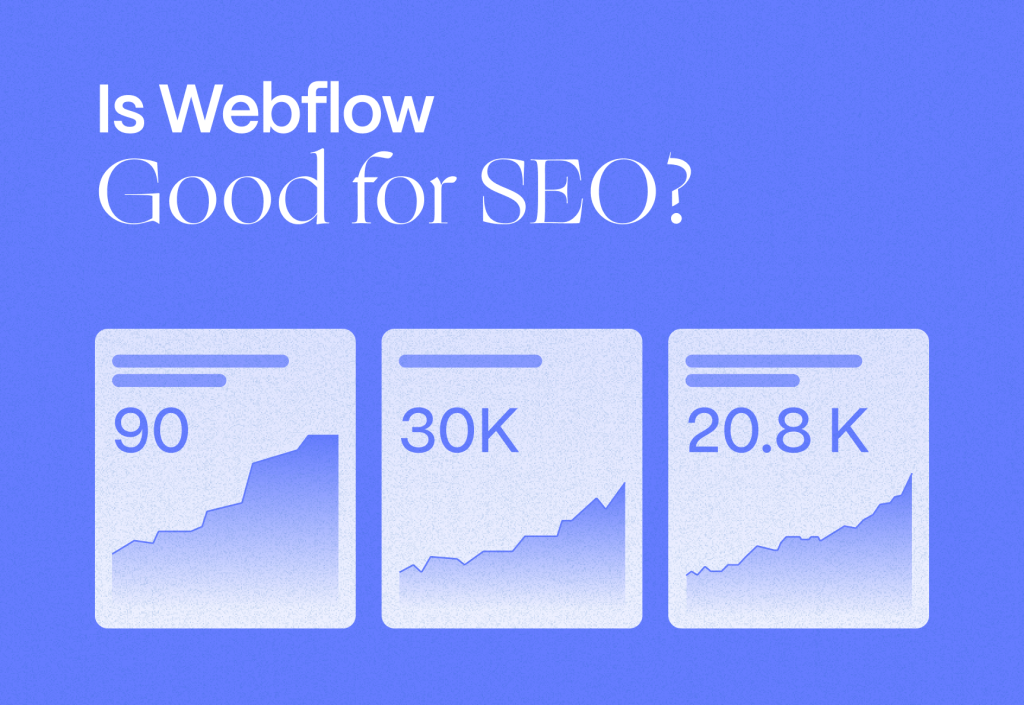The SEO Potential of Webflow
In the ever-evolving landscape of web design and hosting platforms, Webflow has emerged as a popular choice. It offers a user-friendly interface and powerful design capabilities, making it a go-to option for many website creators. However, as we navigate the digital realm, one critical question arises: Is Webflow good for SEO? In this comprehensive guide, we’ll embark on a journey to explore the SEO potential of Webflow and determine if it lives up to the hype.

Understanding Web Flow’s SEO Features
Before we delve into the specifics of Webflow’s SEO capabilities, let’s establish a foundational understanding.
What Is Webflow?
Webflow is a web design and hosting platform that empowers users to create visually stunning websites without the need for extensive coding. It combines the convenience of a visual website builder with the flexibility of a content management system (CMS).
SEO Basics
Search Engine Optimization (SEO) is the art and science of optimizing your website to rank higher on search engine results pages (SERPs). The goal is to attract organic (non-paid) traffic by improving your website’s visibility when users search for relevant keywords.
Webflow’s SEO Toolkit
Now, let’s uncover the SEO toolkit that Webflow offers to its users:
- Meta Tags: Webflow allows you to easily set meta titles and descriptions for your web pages. These meta tags provide essential information to search engines and influence how your site appears in search results.
- Sitemaps: Webflow automatically generates XML sitemaps for your website. Sitemaps help search engines crawl and index your site more effectively.
- Clean URL Structures: Webflow produces clean and user-friendly URL structures, which can positively impact SEO. Customizing URLs for specific pages is also straightforward.
With these SEO fundamentals in mind, let’s move forward to explore the advantages and limitations of using Webflow for SEO.
Pros and Cons of Using Webflow for SEO
As with any web design and hosting platform, Webflow comes with its own set of advantages and limitations in the context of SEO. Let’s dive into these aspects to gain a comprehensive understanding.
The Advantages
Webflow offers several advantages that make it an attractive choice for SEO-conscious website creators:
User-Friendly Interface
Webflow’s visual design interface makes it accessible to both beginners and experienced designers. You can easily create and customize web pages, optimizing them for SEO without needing extensive coding skills.
Responsive Design
In today’s mobile-driven world, having a responsive website is crucial for SEO. Webflow’s templates and design tools are inherently responsive, ensuring that your site looks and performs well on various devices, including smartphones and tablets.
Hosting and Security
Webflow provides hosting services, which can simplify the technical aspects of website management. Additionally, it offers secure hosting with SSL certificates, contributing to a secure browsing experience for your visitors.
The Limitations
While Webflow boasts several strengths, it’s essential to consider its limitations from an SEO perspective:
Limited Server Control
Unlike self-hosted CMS platforms, Webflow users have limited control over server settings. This means you may have less flexibility in optimizing server-related aspects, such as server response times.
Hosting Options
While Webflow’s hosting is convenient, it’s also the default option. Some SEO experts prefer alternative hosting solutions for specific projects, and Webflow’s hosting might not always align with their preferences.
Customization Complexity
While Webflow offers a range of customization options, achieving highly intricate and unique designs might require more time and expertise. This complexity can impact SEO indirectly if it leads to delays in website development.
Case Studies
To gain a practical understanding of Webflow’s impact on SEO, let’s explore a few case studies of websites using the platform:
- Case Study 1: A small e-commerce business used Webflow to redesign its website. The user-friendly interface allowed for quick updates and optimizations. Within six months, the website saw a 40% increase in organic traffic and a significant boost in conversion rates.
- Case Study 2: A large content-focused website migrated to Webflow from a traditional CMS. While the migration initially caused a slight dip in traffic, the site’s SEO improved significantly in the long run due to the platform’s responsive design and streamlined SEO features.
- Case Study 3: A startup with limited coding resources chose Webflow for its simplicity. While they achieved an aesthetically pleasing website, SEO optimization proved challenging due to the complex structure of their content. They eventually hired an SEO expert to assist with on-page optimization.
These case studies demonstrate that the effectiveness of Webflow for SEO can vary based on individual circumstances and optimization efforts. In the next section, we’ll delve into best practices for SEO in Webflow to maximize its potential.
Best Practices for SEO in Webflow
Now that we have examined the advantages and limitations of using Webflow for SEO, it’s time to explore best practices. To make the most of Web flow’s capabilities and boost your website’s search engine visibility, consider the following strategies:
On-Page SEO
1. Content Optimization
- Keyword Research: Conduct thorough keyword research to identify relevant keywords for your niche.
- On-Page Elements: Optimize meta titles, descriptions, and header tags for each page.
- High-Quality Content: Create informative and engaging content that addresses user intent.
2. URL Structure
- Clean URLs: Leverage Webflow’s clean and customizable URL structures for user-friendliness and SEO.
3. Image Optimization
- Alt Text: Include descriptive alt text for images to improve accessibility and SEO.
Off-Page SEO
1. Backlink Building
- Quality Over Quantity: Focus on earning high-quality backlinks from authoritative websites in your industry.
- Guest Blogging: Consider guest posting opportunities to build backlinks and authority.
2. Social Signals
- Social Media Sharing: Promote your content on social media platforms to increase visibility and potentially earn social signals that can benefit SEO.
Mobile Optimization
1. Responsive Design
- Ensure your Webflow site is fully responsive to provide an excellent user experience on mobile devices.
2. Page Speed
- Optimize images and minimize code to improve page load times, which is a crucial factor in mobile SEO.
While implementing these best practices, keep in mind that SEO is an ongoing effort. Regularly monitor your website’s performance using analytics tools and make adjustments as needed to maintain or improve your search rankings.
FAQs – Addressing Common Concerns
To provide you with a more comprehensive understanding of Webflow’s SEO capabilities, let’s address some frequently asked questions (FAQs) that often arise in discussions about SEO and Webflow.
Is Webflow SEO-Friendly?
Answer: Yes, Webflow is designed with SEO in mind. It offers built-in SEO features like customizable meta tags, clean URL structures, and automatic XML sitemaps. However, effective SEO still requires strategic content optimization and off-page efforts.
Can I Customize SEO Settings in Webflow?
Answer: Absolutely. Webflow provides customization options for meta titles, descriptions, and headers on a per-page basis. You can tailor these settings to align with your SEO strategy for individual pages.
How Does Webflow Handle Site Speed and Performance for SEO?
Answer: Webflow’s hosting includes features aimed at optimizing site speed and performance, such as content delivery network (CDN) integration and automatic image compression. However, your specific site’s performance also depends on factors like image optimization and design choices.
Are There Any SEO Plugins or Integrations for Webflow?
Answer: While Webflow does not rely on plugins like traditional CMS platforms, it offers integrations with various third-party tools. You can use these integrations for tasks like keyword research, analytics tracking, and backlink monitoring to enhance your SEO efforts.
Does Webflow Support Structured Data and Rich Snippets?
Answer: Yes, Webflow supports structured data and rich snippets. You can add structured data to your site’s HTML to provide search engines with additional context about your content. This can enhance how your site appears in search results.
What Are the SEO Success Stories with Webflow?
Answer: SEO success with Webflow is achievable with the right strategy and execution. Numerous websites have experienced substantial traffic growth and improved search rankings after migrating to or building their sites on Webflow. These success stories highlight the platform’s potential for SEO when used effectively.
Is Webflow Suitable for E-Commerce SEO?
Answer: Yes, Webflow is suitable for e-commerce SEO. It offers e-commerce functionality and provides SEO features necessary for online stores. To excel in e-commerce SEO, focus on optimizing product pages, implementing structured data, and building a strong backlink profile.
How Do I Migrate to Webflow Without Losing SEO Rankings?
Answer: Migrating to Webflow without losing SEO rankings requires careful planning. Start by creating 301 redirects from old URLs to new ones. Ensure that meta tags and content are consistent, and submit updated sitemaps to search engines. Monitor your rankings post-migration and make necessary adjustments.




